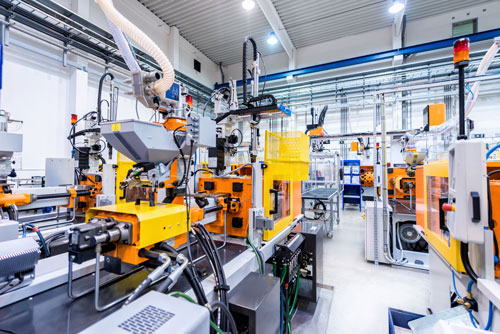自動化設備の設計・開発

設備の自動化・ロボット化は重要 :
産業のグローバル化の勢いは日々増すばかり。
日本の工場は海外に対抗できる技術力を持ち、品質に対するプライドは匠の精神で世界の追随を許さないことは、自他ともに認めるところであります。
一方で、アジアを中心とした諸外国の技術力、品質も急激に追い上げてきていることも事実です。
すでに加熱した価格競争の渦中にあるといっていいでしょう。
多少の品質の差であれば、コストの安いところから調達することが当たり前の時代になりました。
そんな情勢の中、コストでも対抗するためには、日本の産業に必要なのは、設備の自動化、ロボット化です。
匠の精神をつぎ込んだ自動生産ラインの整備は、まさに急務です。
自動化・ロボット化の技術 :
エキスパートギグでは、主に自動車部品の生産ライン向けの生産設備の開発を多数手がけてまいりました。開発した設備は数百種類に及びます。
エキスパートギグの設備開発の歴史は、親会社である株式会社渡辺製作所からスタートして約60年。試行錯誤しながら同社の発展の礎となり、現在もその重要な役割を果たしています。
渡辺製作所の創業者である故 渡辺 秀雄 社長による様々なアイデア・からくりから始まり、その精神はアイデアマンとして活躍している二代目の渡辺 博 現社長によって昇華され、現在に至っています。
弊社の設備設計は、可能な限りシンプルに設計するという理念に基づき、原理・原則から外れることのない一貫した設計・開発を行っています。
なぜなら、複雑な設計は往々にして、部品点数が多くなり、調整箇所が多くなり、部品の故障も多くなり、設備償却の負担も増大してしまいます。また、作業者にも熟練が必要となるなど工場にとってデメリットが多いものになってしまうからです。
ラインの自動化・ロボット化について、弊社は3のパターンに分類します。
- ・手作業で行っている加工の自動化
- ・複数工程を1つの設備に集約する自動化
- ・既存設備を活用しその間を取り持つロボット化
どのパターンで設計するのか悩まれるケースも多いかと思いますが、弊社はこれらに対してもシンプルな考えをもってご提案いたします。工場が抱える様々な悩みを皆さんといつも同じ目線で見て、感じて、改善に取り組んでいる弊社だからこそのアドバンテージです。
実際に現場に投入されているラインの見学もできますので、お気軽にお問合せください。
そして、皆さんが現在抱えている悩みを聞かせてください。
Many of the technologies we use every day have been getting smaller, faster and cheaper each year – with the notable exception of batteries. Apart from the possibility of a smartphone which lasts for days without needing to be charged, the challenges associated with making a better battery are holding back the widespread adoption of two major clean technologies: electric cars and grid-scale storage for solar power.

“In their simplest form, batteries are made of three components: a positive electrode, a negative electrode and an electrolyte,’’ said Dr Tao Liu, also from the Department of Chemistry, and the paper’s first author.

In the lithium-ion (Li-ion) batteries we use in our laptops and smartphones, the negative electrode is made of graphite (a form of carbon), the positive electrode is made of a metal oxide, such as lithium cobalt oxide, and the electrolyte is a lithium salt dissolved in an organic solvent. The action of the battery depends on the movement of lithium ions between the electrodes. Li-ion batteries are light, but their capacity deteriorates with age, and their relatively low energy densities mean that they need to be recharged frequently.

Over the past decade, researchers have been developing various alternatives to Li-ion batteries, and lithium-air batteries are considered the ultimate in next-generation energy storage, because of their extremely high energy density. However, previous attempts at working demonstrators have had low efficiency, poor rate performance, unwanted chemical reactions, and can only be cycled in pure oxygen.

What Liu, Grey and their colleagues have developed uses a very different chemistry than earlier attempts at a non-aqueous lithium-air battery, relying on lithium hydroxide (LiOH) instead of lithium peroxide (Li2O2). With the addition of water and the use of lithium iodide as a ‘mediator’, their battery showed far less of the chemical reactions which can cause cells to die, making it far more stable after multiple charge and discharge cycles.

By precisely engineering the structure of the electrode, changing it to a highly porous form of graphene, adding lithium iodide, and changing the chemical makeup of the electrolyte, the researchers were able to reduce the ‘voltage gap’ between charge and discharge to 0.2 volts. A small voltage gap equals a more efficient battery – previous versions of a lithium-air battery have only managed to get the gap down to 0.5 – 1.0 volts, whereas 0.2 volts is closer to that of a Li-ion battery, and equates to an energy efficiency of 93%.

お問合せ
電話でのお問合せは 0284-33-09060 までお願いします。
